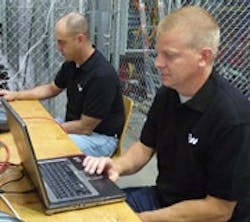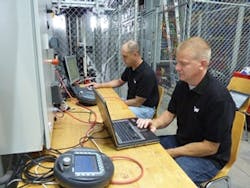Innovator Sorts Its Controls Options
Based in Spring Lake, Michigan, TGW Systems (www.tgwsystems.com) provides integrated logistics solutions and material handling equipfment. The company's offerings include mini- and unit-load automated storage and retrieval systems (AS/RS); and carton, tote and unit conveyor/sortation systems, including the Turbo Narrow Belt Sortation System, a significant advancement that won TGW a Control Design Innovator Award last year.
The Turbo sortation system garnered the award for its use of the latest controls and automation technology to make a faster and more efficient machine. Moving at up to 425 ft/min, it's a pop-up wheel conveyor with a throughput of up to 200 cartons per minute (cpm), at a much lower cost than a sliding-shoe sorter. See more about this Innovator Award achievement at www.controldesign.com/2009innovators.
TGW targets several vertical industries, including food/beverage, general distribution, apparel and retail. Although these industries make very different things, they are all somewhat similar in how they distribute products, according to Potter. "The retail sector, particularly the direct to consumer (online ordering), does have to deal with a larger reverse logistics issue," he says.
Technologies are focused on moving loads—whether a case, carton, tote, or a full-size pallet or unit. The company's high-performance mini-load stacker cranes (also known as AS/RS) have a variety of load handlers for a wide range of carton, tote, and custom tray/load carrier applications—warehousing, in process, automotive, etc. Depending on the type of stacker crane, it can be equipped with up to four load handlers; some load handlers can accommodate up to four loads each.
The PLC-based AS/RS machines are connected by means of wireless communications from off-board, fail-safe PLCs to onboard distributed control components such as Ethernet I/O, single and/or multi-axis servo controllers with encoder feedback for motion control precision, distance measuring lasers, and other components. Also standard with every AS/RS is a hot-pluggable interactive operator control, HMI module. "This device is a mobile HMI with quick-connect means, and can be connected to respective PLC AS/RS machine controllers at multiple remote points either onboard or at the end of each AS/RS aisle," Potter says.
In support of green technologies, Potter adds, TGW incorporates an integrated power supply with a regenerative module that returns power back to the main utility grid. "Without regenerative technology, this valuable commodity would otherwise be dissipated as heat through braking resistors," he says. "By incorporating this type of green technology into the engineered design of TGW AS/RS machines, the majority of the power is essentially back-fed to the grid and thus an end user realizes savings based on the amount of recycled energy and reduced consumption ratings."
For integrated safety/safety-over-bus, TGW uses Profisafe technology, which allows for a single network architecture for both standard automation and safety-related automation. This translates into reduced costs for installation and total cost of ownership (TCO), Potter says.
The machine builder's after-sales support has been helped by such technology advancements as embedded code to monitor critical components of a machine that output to key performance indicators (KPI). "End users now have the ability to use the KPI tools in a manner that allows them to predict critical component maintenance intervals with scheduled downtime for preventative maintenance," Potter says. "This not only increases productive uptime through the ability to effectively maintain and service the machine, but also measures system performance and reliability." In conjunction with KPIs, technical training is a critical aspect of all complex integrated systems, including electrical-controls, software and mechanical skill sets, he adds.


